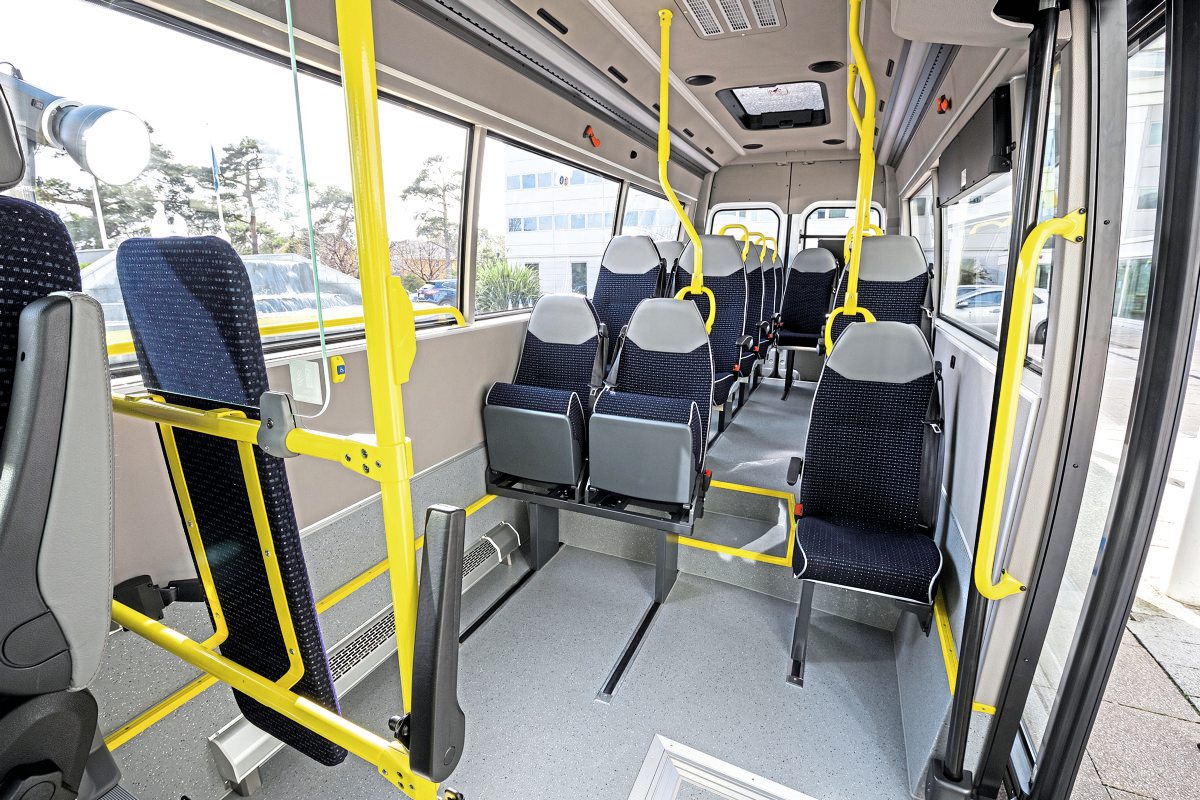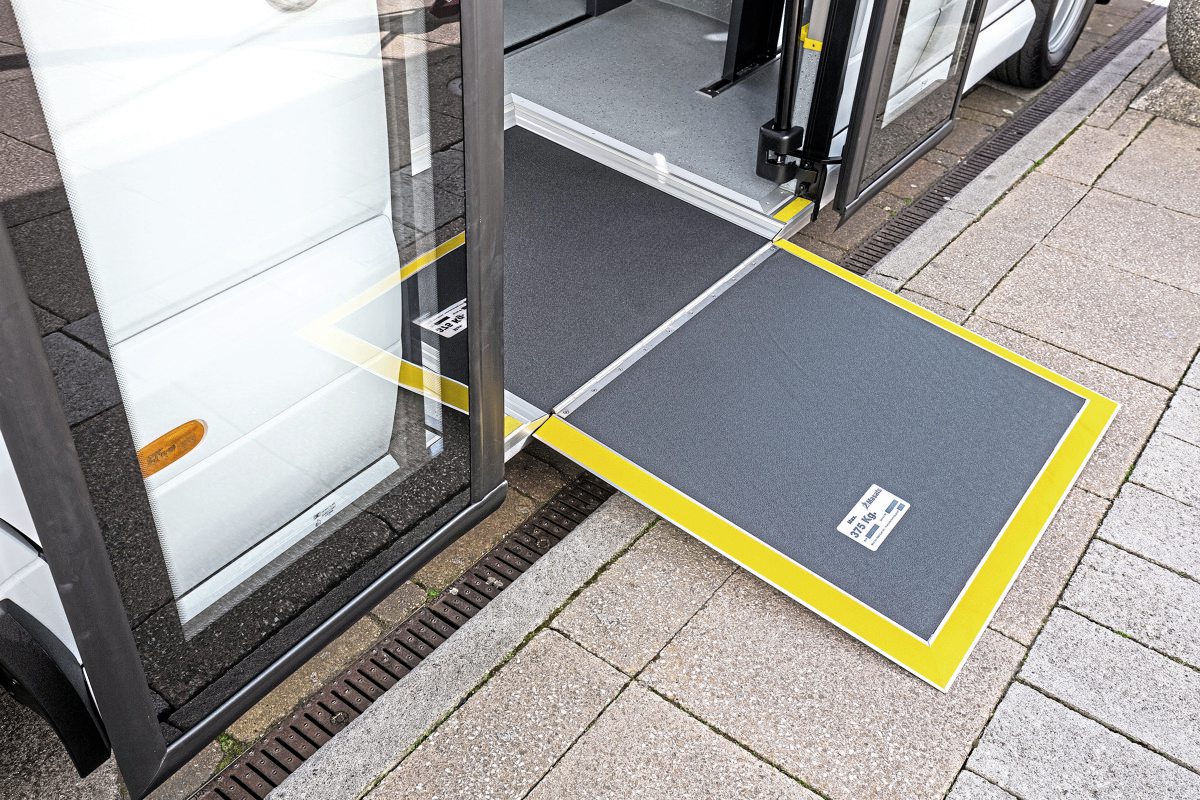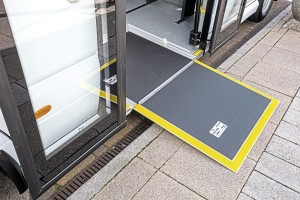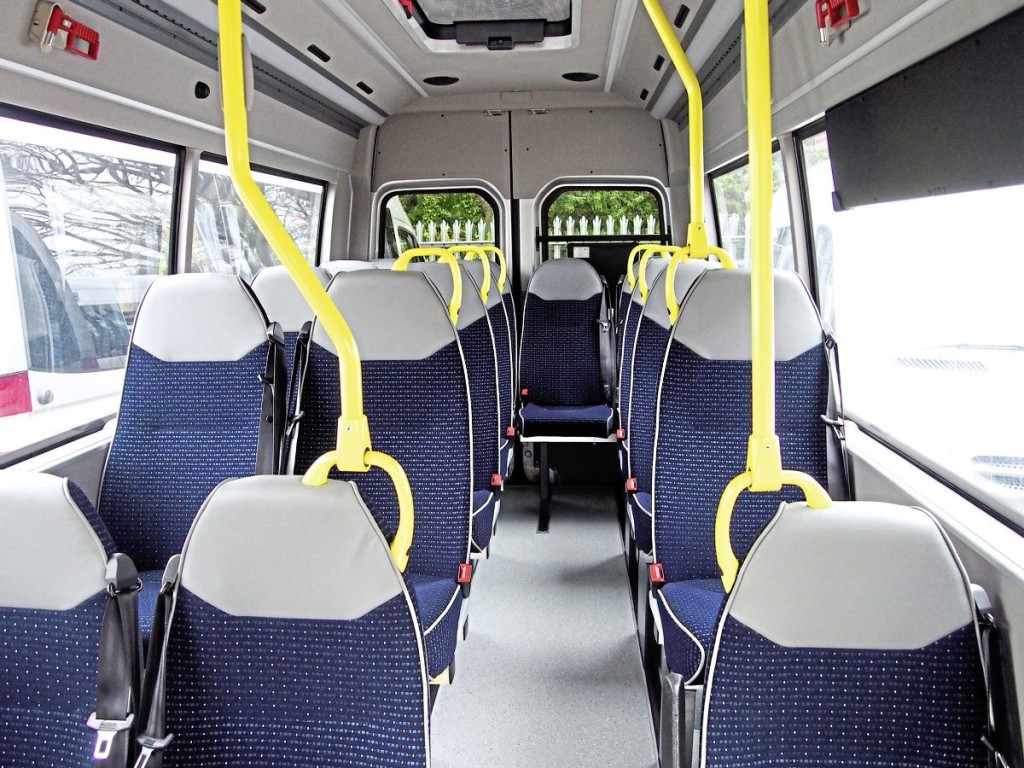EVM’s lowfloor Sprinter success
The converter’s accessible, lowfloor Sprinter range seems to have really taken off since its launch four years ago
Four years ago, EVM made its debut in the lowfloor accessible market with a lowfloor Sprinter minibus conversion. Having earned renown in the executive minicoach sector, the business has now experienced considerable success with this newest concept, most notably with one of EVM’s largest ever orders to a school service provider (more on this later).
Bus and Coach Buyer covered the model when it was launched, with Rob Orchard test driving it. There have been some interesting developments with it over the years and Chris Peat visited the converter’s Crawley site to chat to Sales and Marketing Director, Peter Flynn, about how it has developed.
Versatile
Talking about EVM’s first foray into this area, Peter said: “Moving into this market, we thought there would be growth for us and we thought we could bring something new. Our drive at the time was to bring the reliability and quality of the EVM brand to the lowfloor market. Prior to that, lowfloors were thought of as almost the poor relation.”
The Sprinter was designed to be as versatile in its uses as possible, with city services, airport shuttles, park and rides and community transport schemes in mind. There were three main fundamental issues Peter said EVM wanted to address in the lowfloor area. Firstly, the doors; they were considered very unreliable on these vehicles, which often employ plug doors. These, he claimed, often have the problem of suffering from moisture damage and problems associated with exposed mechanisms. To overcome this, EVM fits a Masats double rapid-sliding door. Peter said: “The beauty of it is it’s one mechanism that sits on a single guide rail. You get no knocks on it, it’s out of the way. It pops forward 10cm to open. It’s very simple and very reliable. Masats give us good support for it too. It wins on height and speed of opening, which helps maintain the temperature in the cab and saloon.” Also helping to keep a warm temperature onboard are the double-glazed windows.
Like all of its suppliers, EVM fully vets Masats to ensure they deliver the quality it needs. The Spanish company supplies every power door the converter fits.
The second issue was ensuring a reliable drive system, which he said EVM’s lowfloor Sprinter addresses with its better designed drive shaft. The original drive shaft is used, which is completely protected by the structure of the lowfloor.
The other element is price, with Peter saying the £82,000 plus VAT price tag for the entry level model is competitive. Currency changes between the Euro and pound, as well as the affects of the Brexit vote have impacted this initial figure.
EVM came up with its Community and City variants of the lowfloor Sprinter, addressing these issues. Entry height was also carefully considered with these models, which is 27cm, making it the lowest on the market for this. “Yet we still get 20cm ground clearance. And we have never had a bus ground out, such as on a particularly steep sleeping policeman or anything.”
A Masats ramp is fitted, a single-leaf design giving a low profile and footprint in the lowfloor. The design of the ramp means a wheelchair user should experience a smooth transition from ramp to floor from any angle, which Peter said is unlike a cantilevered ramp used in other models.
On releasing the lowfloor model, it was not long before the first of these was delivered, going to Cumbria-based Fellrunner. Operators like this are common customers for this vehicle, with community groups and councils also placing orders.

One of the advantages of the EVM lowfloor Sprinter is its ability to navigate tight streets easier than larger vehicles
Peter said he often talks to community transport groups about EVM’s lowfloor Sprinter. He said: “It is a very interesting sector. They will often bring out the oldest and most infirm of their customers to test the bus. I have been to one end of the country to the other with it, figuring out what they would want from an end user perspective.”
One of the first bits of feedback Peter got on the vehicle was from a driver at Cuckmere Bus (thought to be the oldest community transport group in the country), who EVM often works with to help develop vehicles. Peter said: “The first thing the driver said when he saw it was: ‘That’s a better solution, you can get closer to the curb.’ What he was talking about was the bottom of the vehicle, which does not curve away from the curb like the standard sprinter bodyline”
The design of the lowfloor means the body of the vehicle is closer to the kerb by almost 80mm meaning the driver can get the vehicle closer to the kerb and still be able to open the rapid-sliding door. In certain cases the wheelchair user can enter the vehicle without even deploying the ramp. Peter claimed it is the only vehicle that can pull up and open beside Tesco supermarkets’ access step, a textured pavement surface raised up to facilitate less-able bodied people to alight nearer the entrance of the shop.
Commenting on the size of the lowfloor Sprinters, Peter said: “It’s not just that they can go in and around narrow streets, two vehicles can also pass by one another, which is an important point an operator pointed out.”
Complete accessibility
Peter believes the lowfloor Sprinter allows complete accessibility for wheelchair users and other less-able bodied people alike. For instance, it has been designed to allow wheelchair users to board and alight without assistance, being able to secure their wheelchair themselves. “Dignity” for persons of all mobility is what Peter said the company is trying to achieve with this design.
Up to 40% of passengers can sit in the lowfloor section of the Sprinter, Peter said. This means they do not need to climb the step up to the next section. A thin Masats fold-out manual ramp is fitted to the door, allowing wheelchair users access to their dedicated bay, which includes a safety belt and back board.
Prompted by feedback from customers, another design feature EVM has put in place is a staggered series of handholds throughout the vehicle, ergonomically placed. The layout has been created with less-able bodied and elderly passengers in mind, who often take one step at a time, standing with both feet together between strides, rather than placing one foot in front of the other with each movement. The spacing between seats has been adjusted with this in mind. Peter said: “We want to meet as many requirements of the end user as possible. Everything is a compromise, but we have to get it to meet the needs of passengers. We have listened to the end user and we think we have ticked as many of these boxes as possible.
“For me, something that has always been of interest is the idea there should really be no difference between a big bus and an accessible bus. On a general day to day service, I don’t think the bus I take should be any different to the one wheelchair users use.
“Coming from our background, the more executive to luxurious end, we bring a different approach to others in this area.” He said the company is used to the comparatively more complex builds of minicoaches and has brought its expertise into this area. “Complicated build requirements are our bread and butter.”
The bespoke nature of EVM’s minicoach conversions has crossed over into the lowfloor Sprinters too, with there being some examples of higher spec versions of the vehicles than the standard range. Extra features, such as USB ports, wifi and GPS can all be added. There are also multiple seating and storage options. “Our background lends itself very well to this. We can adapt to what the customer needs.”
Small bus
The vehicle could perhaps be described as a small bus rather than a minibus. The interior has certainly been designed to emulate the environs of a larger bus, with Peter highlighting the open and airy feel of it. One way this has been achieved is by installing tip-up seats in the lowfloor area, providing a more open environment. “We have always seen the future of this bus as on service routes. We want it to be a case of passengers getting out of a big bus and into a smaller bus like this, which is just as nice and open. It’s much more light-filled than other minibuses this size. It’s about doing as much with that compromise on space as we can.”
Despite being a small bus, a notable point is that it is fully tested and approved to carry up to 25 passengers, 16 seated and nine standees. This, Peter claimed, is the largest capacity for this size vehicle on the market.
Peter envisions the vehicle being used by service operators tendering for contracts, but then getting the added value of putting smaller vehicles on service at off-peak times. It could also be used for connector services between stations, linking up routes that use larger buses. This provides a cleaner and more environmentally friendly solution than full-size vehicles.
This idea has been embraced by several operators and councils throughout the UK with the EVM Lowfloor proving itself on varied routes throughout the country. The ability to carry up to 25 passengers on a much more flexible and economical solution being enough to win over both the service operator and awarding council.
Another operational model he sees it suiting is one similar to Arriva Click, which uses the Sprinters. There are no scheduled routes as such, but the vehicles on the service are guided through the streets using an algorithm that links the whereabouts of passengers with the best vehicle for them to catch, with customers booking transport using an app.
Peter said: “I read a study ten to 15 years ago that predicted a move away from big buses. We are seeing a drive towards smaller buses at the moment.” This size of vehicle could play a significant part in enabling Mobility as a Service (MaaS), he believes, providing true door to door travel. “It’s an exciting solution. Our vehicle could tie that all together well.”
Continual development
The Community and City have been developed and revised continuously since the launch of EVM’s lowfloor Sprinter range four years ago. An example is the heating system, which has changed from a series of blowers to convector heating. Peter said: “This is something we have done in our coach side. We see passengers don’t really like hot air blowing in their faces.”
EVM has moved away from amber lettering on its Hanover destination displays and now uses white. The advantage, Peter says, is it gives a higher contrast, making it easier to see for those with vision loss. It has even worked on redesigning the driver area to incorporate a ticket machine, luggage area and a driver protection screen.
This ongoing development is something set to continue, with constant improvements the order of the day with the converter. Customers play a key role in this, with Peter saying: “If you come here and have a good idea, it could be on all of our vehicles.”
Peter said: “We’ve had a lot of success with it. We have gone from a very small number being sold to a substantial number.” The initial drive that got sales momentum going was from community transport, with the aid of the Community Transport Minibus Fund. Peter said: “The people in Community Transport are all great, they have so much experience and are great at pulling funding out of the box.”
The next customer-type to take to it after community transport was councils. Peter said: “I work with local authorities to make them aware of the vehicle, why it is different and why it is better. It’s about building awareness, councils appreciate that and they have been involved in the development of the vehicle.” Peter can even visit councils on customers’ behalf, bringing a demonstrator with him.
Interest for the company’s lowfloor Sprinters is certainly growing, with their sales making a considerable percentage of its income in such a short period of time. In addition to the OneBus order and the high-profile Arriva Click roll out, Peter said even more exciting developments are set to come with the lowfloor Sprinter.
Contact: Peter Flynn on 0845 5205160 or 0771 5473354
Specifications
Passenger capacity: 25 (16 plus nine)
Base vehicle: Mercedes-Benz Sprinter 516 CDI 2.2ltr 160bhp
Gearbox: Automatic with a manual switch option
Size options: 5tonnes or 5.5tonnes
Ground clearance: 20cm
Entry height: 27cm
Wheelchair ramp: Masats single leaf
Door distance from body: 10cm
Glazing: Panoramic double glazing
Chassis warranty: Three years unlimited mileage
Extended chassis warranty: Five years unlimited mileage
Additional features: up to 18 USB points, Icomera M310 wifi unit
£12 million order
Perhaps one of the more notable developments for EVM’s Sprinter products is the order from OneBus for 260 12 seater Trends. A £12m deal, it sees the company supply the vehicles in conjunction with Northside Truck and Van of Sheffield. OneBus is a not-for-profit company, wholly owned by Focus Learning Trust operating a passenger transport service, for educational charities that run schools within the Focus Group of schools.
















